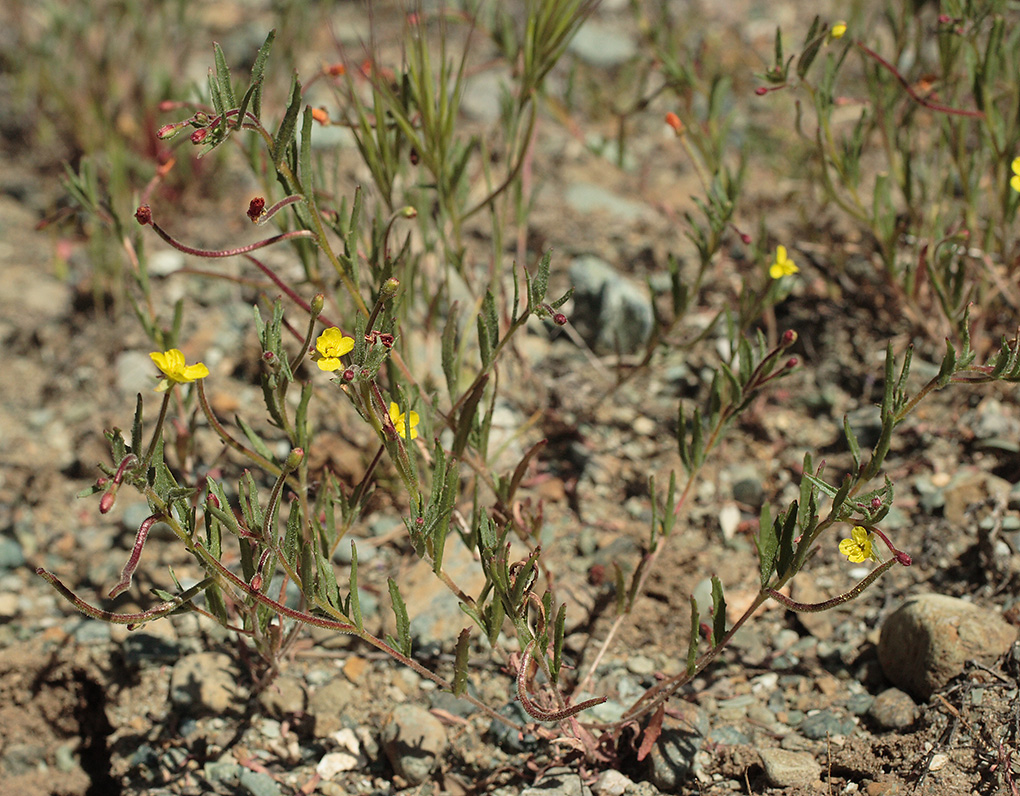San Benito Suncup
(Camissonia benitensis)

Description
Camissonia benitensis was discovered by Peter H. Raven on a serpentine stream terrace adajcent to Clear Creek (New Idria serpentine mass; Bureau of Land Management Clear Creek Management Area) in 1960 and scientifically described by him in 1969. The plant's specific epithet, "benitensis", commemorates its discovery in San Benito County. It is a diminutive annual herb that rarely grows larger than 10 centimeters in field conditions, but can become multi-branched and exceed 30 centimeters in diameter within a horticultural setting. Its reddish stems bear plentiful linear leaves less than 1 centimeter long and minutely toothed along the edges. Plants bear four-petaled yellow flowers approximately 6 millimeters in diameter. Flowering occurs in April and May, opening in the morning and closing in early afternoon. The species is fully self-pollinating. The fruit is a cylindrical capsule up to 4 centimeters in length. The fruits remain largely closed at maturity and spring open upon wetting with the first fall rains, dispersing seeds. Seeds are tiny (1 millimeter long, 0.5 millimeter wide) and black to brown in color. The seeds have a smooth seed coat and weigh approximately 0.1 milligram each. Long-distance dispersal likely occurs as seeds in mud stuck to animals or vehicles. Seeds germinate with the first rains in fall or winter. Camissonia benitensis bears a close resemblance to Camissonia contorta. The two species are virtually indistinguishable with the naked eye when plants are small (under 6 centimeters), as is common in their native habitat, where they occur together. Camissonia strigulosa also grows in this range but is distinguishable by its smaller flowers and prostrate habit. They dichotomous keys in The Jepson Manual first edition are not detailed enough to make certain positive identifications. One key characteristic that can help distinguish the three species is the morphology of the trichomes on the distal inflorescences. C. contorta has trichomes that look like transparent glassy rods. C. strigulosa has white linear or lance-shaped blades. C. benitensis has both kinds of trichomes. This key characteristic was lacking in Jepson Manual first edition, but is now included in Jepson Manual second edition. A Camissonia which resembles either C. contorta or C. benitensis growing on serpentine soil in upland geologic transition zone habitat or serpentine stream terrace habitat within serpentine masses is virtually always C. benitensis. A Camissonia resembling either of the two species on serpentine stream terraces outside of serpentine masses or mixed alluvium stream terraces could be either C. contorta or C. benitensis. C. strigulosa is the common Camissonia species found growing on nonserpentine alluvial stream and river deposits within the range of C. benitensis.
Taxonomic tree:







